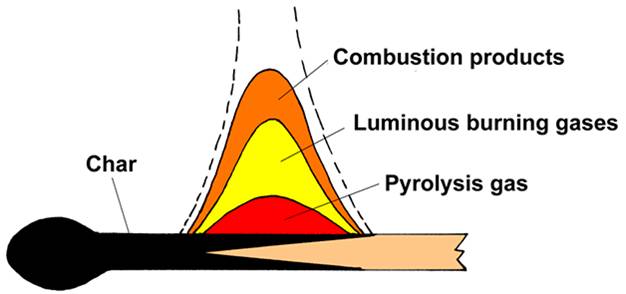Biochar is a carbon-rich product obtained by heating of biomass at relatively high temperatures (300-700°C) in an enclosed chamber with little or no available oxygen (Roberts, Kelli G., et al. 2009). Process of biochar formation is called as pyrolysis (Fig 1). Literal meaning of pyrolysis is breaking down (lysis) of a material by heat (pyro).
The gases which is released during pyrolysis is called as “syngas”. This is an old age practice which basically converts agriculture waste into a soil fertility enhancer. Naturally biochar is formed due to forest and vegetation fire. Study of biochar get a pace after intensive study of biochar rich dark earth in Amazon jungles which is called as Terra Preta (“dark earth”). Physically biochar is a fine-grained, highly porous charcoal. Any types of lignocellulosic material can be utilized for production of biochar such as agriculture waste, paper products, animal waste, poultry waste and even the urban green waste. Although base material or feed stock, decide the quality of biochar formed. Standard feedstock should match some basic requirement such as 10-20% moisture level and high lignin content. Some good examples are field residues and woody biomass. Utilizing the wrong feedstock can lead to high pH of the biochar and can also contain heavy metals such as cadmium, copper, chromium, lead, zinc, mercury, nickel and arsenic as contaminants, which rather than enhancing the soil quality will destroy it. Biochar can retain between 10-70 % (on average about 50%) of the carbon present in the original biomass.
Biochar can be produced from huge industrial pyrolysis down to individual scales, such as cook burners, thanks to technological advancements. The fundamental reason for such a scale variation is the production's greater temperature range. Technically there are four types of pyrolysis systems for biochar production: (1) slow pyrolysis, (2) fast pyrolysis, (3) flash pyrolysis, and (4) gasification. The temperature employed for the procedure and the amount of solid biochar produced after the process are the main differences between slow pyrolysis (400-500°C) and fast pyrolysis/gasification (800°C). Slow pyrolysis is the most frequent method for producing biochar since it produces 35% more biochar than fast pyrolysis, which produces only 12% (Laird et al., 2009; Meyer et al., 2011).
Applications of biochar in agriculture
Excessive fertilizer and other chemical use have resulted in soil degradation, which is a growing problem in modern agriculture. A number of studies have indicated that biochar has a variety of significant effects, including
- Improvement in soil physical properties viz., bulk density, porosity, water holding capacity, drainage etc.
- Enhancement in nutrient use efficiency and microbial activity
- Increase in water retention capacity of soil
- Absorption of heavy metal from soil
- Alteration of the dynamics of soil microbial communities
- Increase in the cation exchange capacity of soil
- Reduction in emission of greenhouse gases by reducing the burning of crop residues
Future research interventions
Although numerous studies confirm the above-mentioned benefits of biochar for improving soil health and quality, there are still many questions that need to be answered in order to reach a final judgement about biochar's benefits. Because we need to know the answers to these questions before we can advocate biochar for large-scale application.
- How will the soil microbial fauna behave under the presence of a non-degrading carbon source?
- What should be the optimum rate of biochar application in different soils and crops?
- Assessment of long term impact on soil quality and crop health.
- Finding out the technology for the enrichment of biochar.
Conclusion
Biochar production actually reduces the CO2 in the atmosphere by means of converting unstable decaying carbon in plant material to more stable carbon in the form of biochar. Also, studies suggest that biochar improve soil fertility and eventually reduces the cost of production by reducing the consumption of chemical fertilizer. But still due to the prevailing contradiction regarding effect of biochar on soil. More study is required to come to final conclusion and recommending biochar to the farmers.
References
- Laird, N., Sobash, R., & Hodas, N. (2009). The frequency and characteristics of lake-effect precipitation events associated with the New York State Finger Lakes. Journal of Applied Meteorology and Climatology, 48(4), 873-886.
- Meyer, S., Glaser, B., & Quicker, P. (2011). Technical, economical, and climate-related aspects of biochar production technologies: a literature review. Environmental science & technology, 45(22), 9473-9483.
- Roberts, K. G., Gloy, B. A., Joseph, S., Scott, N. R., & Lehmann, J. (2009). Life cycle assessment of biochar systems: estimating the energetic, economic, and climate change potential. Environmental science & technology, 44(2), 827-833.
